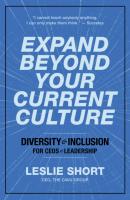Expand Beyond Your Current Culture. Leslie Short
Чтение книги онлайн.

Читать онлайн книгу Expand Beyond Your Current Culture - Leslie Short страница 5
Название: Expand Beyond Your Current Culture
Автор: Leslie Short
Издательство: Ingram
Жанр: Управление, подбор персонала
isbn: 9781947540149
isbn:
I should mention that I was also in charge of the other dancers. As the dance captain I had my own cabin and had to report to the on-shore office how things were going with the show and the dancers.
Before leaving Las Vegas, where we rehearsed for the show, the choreographer held a meeting to explain that I would be the first black person to be on the cruise as an employee. She wanted to prepare the other dancers to answer questions from passengers. Sure enough, one night at dinner one of the dancers, hosting his dinner table, was asked by a wealthy older white woman, “Why is she here? How did she get hired? Why is she in charge of the dancers?”
I wouldn’t have known about the incident if I hadn’t heard Ted’s voice rise above his normal tone and then seen him leave the dining room. Later that night I asked him what had happened. He said, “How dare she ask those questions?” I reminded him of the talk we had before leaving and told him he didn’t have to fight for me, to stay calm, that I would be OK. I told him that she asked what others might have been thinking.
Fast-forward twenty years – Ted and I are connected on Facebook. I saw a post about how saddened he was for black families having to teach their boys about the police and wonder if they would come home at night. He said that he never had to think about that when his sons walked out the door. Where was the fairness and justice in this, and how could he do better? How could he stand up?
I don’t normally respond on Facebook, but I needed to remind Ted that he has always stood up and that writing about his feelings is a form of standing up. Ted is now teaching theater and is still fighting for justice. Being an ally is in Ted’s DNA, and all these years later I still consider him one of my allies.
CHAPTER 3
Checked Boxes Aren’t Good Enough!
MANY COMPANIES THINK that if they’ve checked the boxes described below they’ve followed the law and they’ve done all they need to do to be considered an equal opportunity employer. It should be clear to you after reading this chapter that companies can check the boxes without being seriously committed to Diversity and Inclusion.
Here are a few D&I boxes and, sadly, some real examples of the thinking of some companies in checking them:
You get the point. And I’m not making these up – I’ve heard all of them in meetings!
Once these boxes have been checked, which covers the company by law, they’ll usually do the following: 1) State on their website that they’re an equal opportunity employer; 2) Make it part of their application process; 3) Tell HR to make a diversity effort.
I’ve heard it said in some companies, “It’s not that serious, but why cause issues? Let’s cover our asses just in case someone notices.” The funny thing is, these companies believe they’re an equal opportunity employer.
Be careful of your checked boxes. Companies have asked me how potential employees (or customers) would know whether they are or aren’t committed to Diversity and Inclusion. The answer is obvious – they clearly state that they’re an equal opportunity employer on their website! (And, yes, that’s sarcasm.)
Before people apply for a job with your company, or during the hiring process, here are a few ways They can tell that you don’t really have a diverse culture (let alone an inclusive one.)
• You use stock photos on your website to show that you’re diverse, but you’ve used the same photos that other companies are using.
• They’re told before they arrive to maybe shorten their name.
• You ask Them, “Do you have an American name? One that’s easier to pronounce?”
• You’ve recruited Them for a job They didn’t apply for, and told Them that you got their name “through research.” (Don’t you really want to say that you reached out to your diverse contacts to receive additional resumes?)
• You asked Them, “Would you be comfortable working here?”
• You told Them that They may want to tone it down for the interview or the second interview.
• They walk into the office and see no one who looks like Them or to any “other” culture.
• During the interview, They consistently hear the words they and them.
• They see that there’s no diverse leadership in your company.
• СКАЧАТЬ